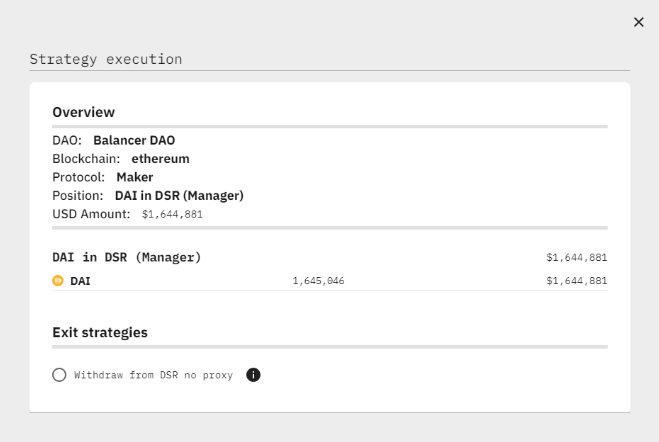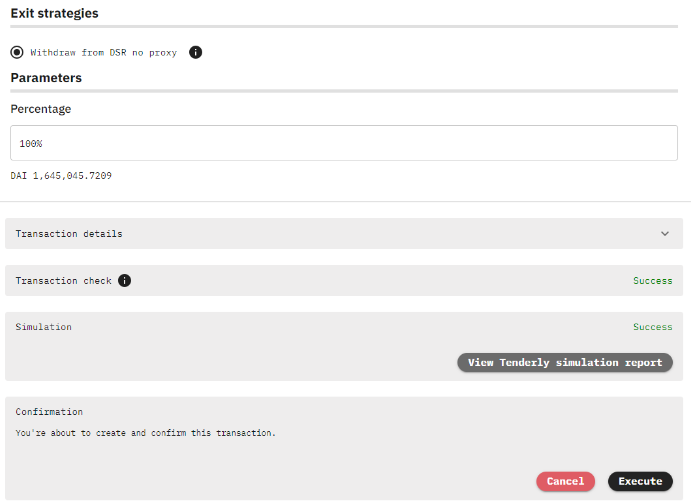Execution
How we build transactions
Transaction Building SDK
Our Transaction Building SDK offers essential tools for interacting with DeFi protocols on behalf of a Safe while utilizing role-based access provided by the Roles Modifier. This library simplifies the process of constructing and executing transactions in DeFi environments.
Transactions created with this SDK are designed to comply with the specific permission requirements set by the DeFi Kit. For example, our SDK provides an easy interface for creating a transaction to deposit ETH into AAVE v3, ensuring that all necessary parameters align with the established permission constraints.
From transactions to strategies for asset managers
The DeFi Repertoire consists of a carefully curated collection of execution strategies crafted with the Transaction Building SDK. It serves as a menu of predefined transactions to interact with DeFi protocols while adhering to the permissions policy enforced by the Roles Modifier.
Strategies range from simple swaps to complex transaction batches encompassing multiple steps and actions, e.g. executing a carry trade by depositing collateral, borrowing an asset, swapping, providing liquidity and staking the position.
The DeFi Repertoire intends to be as comprehensive as possible. For instance, among the Lido disassembling strategies that DeFi Repertoire provides for a stETH holding position we have:
- swapping stETH for ETH on CowSwap;
- swapping stETH for ETH on Curve’s ETH/stETH pool;
- wrapping stETH, and swapping wstETH for WETH on Balancer’s WETH/wstETH pool. Each of these options is carefully thought out to address the diverse needs that may arise in the DeFi ecosystem.
Additionally, the permissions required for each strategy in the DeFi Repertoire are provided by the DeFi Kit, ensuring that they are tailored to the unique needs of each transaction while maintaining proper security and control.
Our Execution Tools
Our Execution Tooling is designed to improve efficiency and simplify asset management. It includes two main components:
Execution App: A user interface that allows asset managers to manually execute transactions.
Automated Operations: System that handles transactions and executes strategies for managing risks and optimizing operations.
Execution App
The Execution App provides three different execution pipelines that can be broken down into two categories:
-
Manager role execution: multisignature-based execution through the Manager Safe + Safe Transaction Service that includes:
- Dapps pipeline: transactions are created through Dapp UI interaction.
- DeFi Repertoire pipeline: transactions are created using the DeFi Repertoire.
-
Programmatic single signature-based execution
- Agile pipeline: transactions are created using the DeFi Repertoire and employing signer EOAs.
Manager Role Execution
The Manager role execution pipelines use the multisignature-based execution through the Manager Safe + Safe Transaction Service.
Dapps pipeline
The Dapps pipeline, supported by Zodiac Pilot technology, allows asset managers to interact with protocol interfaces through a user-friendly wrapper. This setup constructs role-based transactions and directs them to the Manager Safe, enabling asset managers to interact effortlessly with the familiar user interfaces they are accustomed to.
DeFi Repertoire pipeline
The DeFi Repertoire pipeline is a dedicated application with a user-friendly interface designed for submitting strategies directly to the Manager Safe's transaction queue. It reduces reliance on Dapp interfaces, especially during hectic conditions when a protocol's UI might not work properly or suffer from a DNS attack.
Programmatic single signature-based execution: Our Agile Execution App
Our Agile Execution App enables the swift execution of pre-designed strategies tailored to asset managers' specific portfolio needs. This is achieved without the need for a multisignature process.
The app incorporates multiple dedicated signers, which reduces the risk of giving too much power to any single signer, minimises the potential for risky entanglements between permissions policies, and maintains a clearer record for accounting purposes. Permissions are narrowly scoped and built with minimal sets of permissions per strategy, as provided by DeFi Kit.
Asset managers can use various agile roles to accomplish their goals in real-world asset management. These roles include position disassembling, harvesting, carry-trade, anti-liquidation, and more.
How are agile roles created?
The process of creating agile roles follows these steps:
- Asset managers select a specific set of execution strategies from the DeFi Repertoire.
- The permissions policy for the role is created with the DeFi Kit and submitted to asset owners for approval.
- Once approved, these strategies are activated for agile execution via a dedicated signer.
This flexibility allows asset managers to tailor their agile roles based on the needs of the asset owners and their portfolios, boosting overall operational efficiency for both regular tasks and critical situations.
What problem does the Agile Execution App solve?
Reduces dependency on protocols’ user interfaces (UIs): By shifting operations to our Agile Execution App, AM can mitigate the risks associated with UI vulnerabilities, hacks, or malfunctioning interfaces.
Enhances clarity and preparedness during emergencies The app provides a centralized platform for operations, allowing team members to access a comprehensive list of available actions, even in critical situations. This clarity fosters a level-headed approach to handling emergencies, ensuring swift decision-making.
Minimizes Human Error Utilizing the app minimizes the likelihood of human error in executing tasks, particularly in complex strategies. With various strategies readily available within the app's menu, operational mishaps are significantly reduced both in routine tasks and during crisis scenarios.
Saves time and provides operational efficiency The app streamlines repetitive tasks, improving the overall operational efficiency of various processes. The app helps AMs save time and opportunity costs by allowing them to focus on tasks that require human judgment and creativity, thus maximizing the value of their time and expertise.
Provides dual-layer security measures The app ensures a high level of security by implementing dual-layer security measures. Firstly, preset filters act as an initial security check, followed by the execution of predesigned strategies within the app. This layered approach significantly reduces the risk of critical errors occurring due to faulty executions.
What can be executed with the Agile Execution App?
The complete list of available strategies can be found in the DeFi Repertoire and it is expected to expand over time. A selection of these strategies is proposed to each DAO for approval. Once approved, they can be executed by the designated signer.
How does it work?
Execution is carried out through is UI, which generates all necessary transaction payloads with simple, clear, and streamlined actions based on the configuration.
- Landing page:

- Choose position and strategy:

3.The app delivers the payload and Tenderly simulations for execution:

Automated Operations
Our automated system implements automated risk management strategies and manages routine execution tasks. It encompasses bots, automated actions, and guardians. See more in the Automated Operations section.